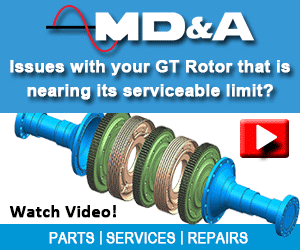The first presentation after opening remarks reviewed how GE communicates with its customers and the value to plant personnel of the OEM’s Technical Information Letters (TILs), Product Service Safety Bulletins (PSSBs), Product Service Information Bulletins (PSIBs), and GEKs covering installation, product specifications, troubleshooting, maintenance, technical recommendations, etc. There’s much owner/operators can learn by becoming familiar with these resources and reading thoroughly sections pertinent to the tasks at hand.
The speaker selected one TIL (2122) and one PSBB (20180709) for detailed coverage. The first focused on replacement recommendations for threaded fasteners; the latter, hexavalent chromium concerns, which had been discussed during the Safety Roundtable the previous day.
The motivation for TIL-2122 was the liberation of a stud in a combustion assembly that caused damage in the hot gas path. The process used in fastener manufacturing was identified as the primary contributing factor and the OEM conducted a risk assessment for all parts supplied by the negligent vendor, which was disqualified based on findings.
A fleet-wide program was initiated to address high-risk applications, with low-risk applications managed through TIL-2122. It advises the replacement of questionable components that are accessible at the next interval; fasteners that are part of an assembly would be replaced in the normal repair process.
Attendees then were reminded of some important older TILs, in particular 1585 and 1986, also mentioned during the Safety Roundtable and listed among Chairman Jeff Gillis’ “Checklist of Safety TILs. . . .”
Focusing on the combustor for a moment, the speaker advised users to review the following:
-
- 1377-3, Extendorized combustion liners, revised stop locations.
- 1437-2, DLN1 liquid-fuel operation recommendations.
- 1770, DLN1/1+ tuning requirements.
- 1952, Modified repair process for 6B standard combustor fuel nozzles.
- 1991, 6B transition piece to S1N floating seal engagement.
- 2041-R2, 6B secondary fuel-nozzle inspection and repair guidelines.
Plus, 1574 and 1713, which also were called out during the Safety Roundtable. Next, the speaker suggested attendees read through these GEKs and GERs and to incorporate their suggestions into the plant’s O&M policy:
-
- GEK111694, Flex hoses.
- 229A6027, Pressure testing of flexible metal hose. Note: All parts are tested by the OEM’s suppliers before shipment.
- GEK121358, DLN1+ gas-only electrically actuated GCV and SSRV.
- GEK 111331, O&M recommendations for media-type gas-turbine inlet-air evap coolers.
- GEK 111787, Combined hydraulic- and lift-oil system.
- GEK 116736, Water-mist fire protection system.
- GER 3620, the OEM’s O&M guidebook. Note: The editors recommend this be read cover-to-cover by all plant O&M personnel.
- GER 4217, a helpful guide to 6A/6B history and upgrades.
Final slide highlighted the value of registering for and using MyDashboard, the OEM’s 24/7 connection for technical, performance, and planning information on your assets. Use it to file warranty claims, view manuals and technical documents, search GE’s solutions database, get outage reports, and much more.
Rotor. The following speaker updated the group on rotor end-of-life (EOL) initiatives. He began with a review of GER 3620 (revision N) and the factoring methodology for hours and starts used in establishing maintenance intervals. Next came a series of highlight slides discussing (1) rotor life and the failure methods and mechanisms that influence it, (2) rotor life management and the inspection-based analytical modeling and analysis used to gauge remaining life, and (3) service-center observations and findings related to 6B rotors. Explanations and impacts of creep, fatigue, and fracture were summed up in a couple of slides on mechanical design and metallurgy.
The presentation’s value to users (access on the Frame 6 website) is familiarization with technologies, concepts, methods, calculations, etc, used in rotor EOL determinations and subject matter they should have a good understanding of.
Improvements. This presentation focused primarily on experience with the Advanced Gas Path (AGP) mod on 6Bs and compressor improvements to extract greater value from your assets. Perhaps you recall that the first AGP for a 6B engine went into service two days before the group’s June 2018 meeting. This speaker reported that as of the 2019 conference five AGP sets had been delivered, with the fleet leader (the first unit) at more than 8000 factored fired hours (FFH). Also mentioned was that beginning this year (2020) all new Frame 6Bs would be AGP-equipped.
The AGP enhancements for a 6B, it was said, typically can deliver from 2% to 15% more power, a heat-rate improvement of up to 4%, an HGP interval of 32k FFH, higher firing temperature, and 2% to 7% more exhaust energy. The exact benefit for a given unit depends an engine’s operating history and component profile.
Regarding the interval extension to 32k FFH, the value is quite significant, going from four major inspections, 16 combustion inspections, and four HGP inspections, for a 200,000-hr lifecycle, to three majors and three HGP inspections. Run a back-of-the-envelope calculation for your 6Bs to get an idea of the benefit for your plant.
A supporting case history (favorable to the OEM), was for an original 6541B coming up on an HGP inspection with a need for new replacement-in-kind parts. The unit, equipped with Mark VI controls and DLN1 Advanced Extendor, operates baseload 8000 hr/yr on natural gas. Assumptions were $50/MWh for power, steam revenue at $5 per 1000 lb/hr, and a fuel cost of $5/million Btu. With a 15% increase in power output, heat-rate improvement of 5.1%, and an increase in exhaust energy of 7.6%, the annual benefit was calculated at $2.3 million in round numbers.
Architectural changes to the compressor and turbine sections are key to the AGP engine’s performance improvements. Advanced airfoil design, use of materials and coatings with greater tolerance to corrosion and erosion, implementation of blade-health monitoring, and use of stainless-steel stator vane segments for the first four compressor stages are among the many beneficial changes. Get more specifics from the presentation posted on the user group’s website.





